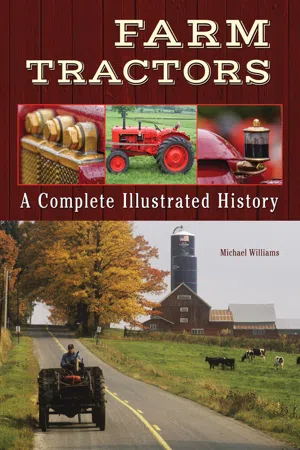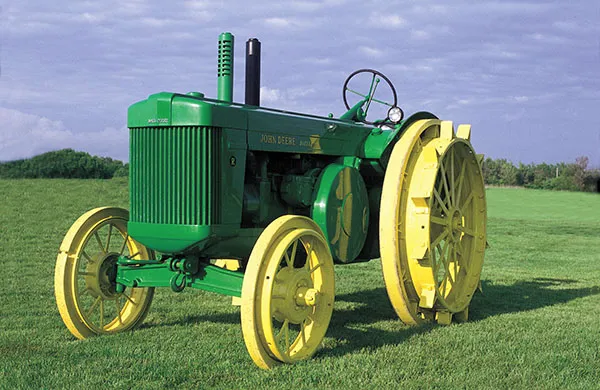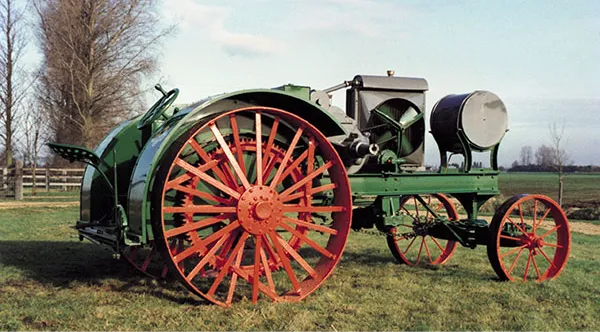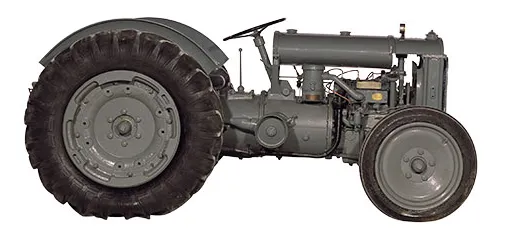![]()
Chapter 3
Designed for Performance
Harry Ferguson’s three-point linkage with hydraulic control was one of the important technical breakthroughs of the 1920s and 1930s. Other power farming developments from this period included the first inflatable tractor tires advertised by Model U racing tractors from Allis-Chalmers, and the arrival of diesel power to boost pulling power and reduce fuel costs. Manufacturers also discovered that stylish lines and eye-catching colors help to sell more tractors.
The launch of Henry Ford’s Model F Fordson in 1917 was one of the most important events in the history of the tractor—many would say the most important. It was the Model F that helped to establish the layout and structure of the modern tractor, and the Model F’s bargain price brought affordable tractor power to many farms for the first time.
Although the Model F was a major milestone in design, there was still plenty of room for further technical improvements to make tractors more productive and efficient, and some of the most important developments were introduced during the 30-year period from 1920. One of the most significant improvements was Harry Ferguson’s hydraulically operated three-point linkage with draft control, which sensed changes in the resistance of the soil against the implement to adjust the working depth and brought the tractor and implement together to operate as a single unit. This was another major development in which Henry Ford played a leading role.
This superbly restored John Deere is a Model R, the company’s first production tractor to be powered by a diesel engine. It was also the most powerful tractor John Deere had built, delivering up to 51 HP, and also set a new record for fuel efficiency.
The first attempts to pull plows and other implements had been based on a hitch point at the rear of the tractor and a drawbar or just a length of chain attached to the implement. It was an inefficient arrangement, as the working depth could vary significantly where there was an undulating surface, field corners and headlands caused problems because reversing with the implement was either difficult or impossible, and the towing arrangement could also be dangerous.
The danger was due to the variation in the height of the hitch point on different tractors; when the hitch was too high, the forces from the implement could make the front of the tractor rear up. This was long before the days of safety cabs, and many drivers were either killed or seriously injured because of tractors rearing over backwards. The Model F Fordson was one of the worst examples of this. In his book Henry Ford and Grass-Roots America, Reynold M. Wik estimates that 136 tractor drivers died and many more were injured on American farms in the five years ending 1922 due to Fordson tractors overturning.
Waterloo Boy tractors were sold in Britain and Ireland under the Overtime name, and distribution in Ireland was controlled by Harry Ferguson’s garage business. The Overtime in the photograph is owned by an English collector, but its first owner was a farmer in Ireland.
Improving Implement Lifts
Providing special hitch points to allow the implement to be attached directly to the rear of the tractor helped to solve some of the problems, and this was the arrangement chosen by a British manufacturer, Burnstead and Chandler of Birmingham, for its 24 HP Ideal tractor. The Ideal was available for about nine years from 1912, and it had a number of novel features that helped to make it complicated and expensive. One of these was a manually controlled differential lock, allowing the operator to direct the power through either the left or right driving wheel only or both together, depending on soil conditions and traction requirements. Also, the driving wheels were equipped with spade lugs attached to a cam that retracted them automatically to prevent a build-up of mud in difficult soil conditions.
Implements were mounted on a frame attached to the rear of the Ideal, and this acted as a hinge point, allowing the implement to be raised above the ground for transport or during headland turns. The lift mechanism was a cable attached to the frame of the implement and powered by the tractor engine.
US manufacturers were also developing power-operated implement lifts. The Hackney brothers from St. Paul, Minnesota, began building their Auto-Plow tractor in 1911, and it was even more unconventional than the Ideal. The design included two driving wheels at the front and a single wheel at the rear for steering, and the high clearance frame allowed space for a mid-mounted plow beneath the tractor. The lift mechanism for the three-furrow plow was powered from the engine and controlled from the driver’s seat. The Auto-Plow was one of the first two-way or bi-directional tractors, designed to work either forward or backward with two seating positions, allowing the driver to face either way. Several versions were built, including one with a 40 HP engine and a later model rated at 30 HP, but production ended in about 1919. The Hackney Auto-Plow and the Nevada Auto Plow have so many similar features—including the three-wheel layout, the two-way operation, the mid-mounted plow with a power lift and look-alike styling—that it is difficult to believe they were not based on the same design. Production started in Nevada, Iowa, in 1913 and ended about two years later. Details of two models have survived, with 25 HP and 60 HP engines.
Other American power lift pioneers included the Lawter company from Newcastle, Indiana, and its 1914 model shared the same three-wheeler layout and two-way driving arrangement as the Hackney and Nevada models. The Lawter also used a mid-mounting arrangement for the plow, and the power lift mechanism was controlled by a foot pedal.
Deere & Co.’s contribution to the development of lift mechanisms started in 1927 with a mechanically operated system on the Model C, predecessor of the popular General Purpose or GP series. This was followed in 1932 by what was probably the first implement lift to be operated by hydraulic power on a tractor. It was available on the Model A rowcrop tractor, and it provided the operator with an easier method of controlling a mounted implement.
Harry Ferguson chose hydraulic power when he developed his system for lifting and controlling implements, and this was the equipment Henry Ford helped to introduce. Ferguson and Ford had much in common; they were both from farming families, but they both disliked the slow pace of working with animal power, and they were both eager to leave home to start a life away from the farm and develop their engineering abilities.
Ford left home to work in Detroit and Harry Ferguson went to Belfast in what is now Northern Ireland to work in his brother’s cycle repair business. The Ferguson brothers expanded the business to include motorcycle and car repairs, helped by Harry Ferguson’s aptitude for repairing the temperamental gasoline engines of the early 1900s. Harry Ferguson later opened his own garage, and he also developed an interest in motor racing. In 1909, he became the first person in Ireland to build and fly his own aircraft.
The first production Ferguson tractor was the Model A or Ferguson-Brown, built by the David Brown company, but designed and marketed by Harry Ferguson. It was the first production tractor equipped with the Ferguson System three-point linkage with hydraulic control.
The Ferguson System
Ferguson’s interest in tractors developed during World War I. Farmers in Britain were encouraged to use tractor power in order to increase food production and Ferguson, with a keen eye for a business opportunity, began selling tractors through his garage. The tractor he chose was the Waterloo Boy, known in Britain as the Overtime, and he took a personal interest in the demonstrations and sales. His expertise with the tractors brought a plea for help from the Irish Board of Agriculture. Board members wanted him to visit the farms in Ireland where tractors were used, and to show the owners and the drivers how to make the most effective use of tractor power.
The tractor tour was completed during March 1917, and it was almost certainly this experience that encouraged Ferguson’s interest in the way in which implements were attached to tractors. By September 1917, he had taken out a patent—the first of many—for an improved plow design. His next development was a plow designed specifically for the recently introduced Fordson Model F tractor, and this linked the plow to the tractor by a pair of struts designed to help maintain a more even working depth and also reduce the risk of the tractor overturning backward. This plow was made in the United States, where it sold in substantial numbers.
Harry Ferguson’s interest in implement attachment and control systems continued, and, during the late 1920s, he and his engineers developed a linkage with three attachment points and hydraulic operation. It was the basis for what was to become known as the Ferguson System, still used as the standard implement attachment and control system on most of the world’s farm tractors.
Ferguson Model A production started with Type E power units supplied by Coventry Climax; by 1938, when this Model A engine was made, the David Brown company was building its own engine. The David Brown version of the four-cylinder engine featured a redesigned cylinder head.
With the design of the attachment and control system virtually complete, Ferguson needed a special tractor he could use to demonstrate the benefits of the equipment in order to attract the interest of a manufacturer. The tractor he designed for the job was completed in 1933. It had a jet-black...






